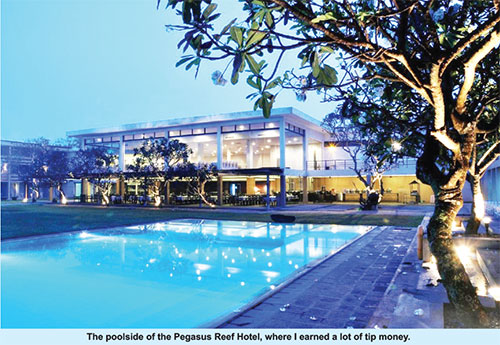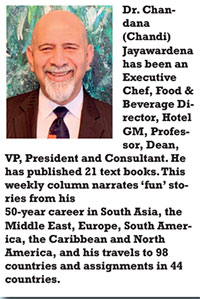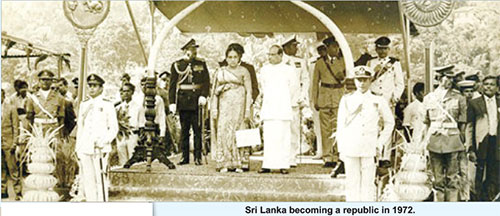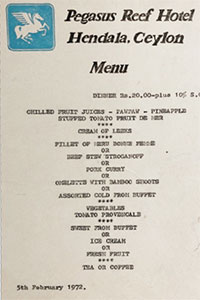Features
CONFESSIONS OF A GLOBAL GYPSY – Part 6

TRUE INDEPENDENCE, FINALLY!
By Dr. Chandana (Chandi) Jayawardena DPhil
President – Chandi J. Associates Inc. Consulting, Canada
Founder & Administrator – Global Hospitality Forum
chandij@sympatico.ca
Becoming an adult
Turning 18 gave me a good feeling. I felt that I now have legitimacy in being at the Ceylon Hotel School (CHS) as I was not underage anymore. Living in the hostel  and making all decisions (good and bad) to enjoy life and career building also enhanced the feeling of being independent. My father visited me briefly at the hostel on Wednesday evenings every week to check how I was progressing. I think that he did so to mainly to please my mother who was always worried about me.
and making all decisions (good and bad) to enjoy life and career building also enhanced the feeling of being independent. My father visited me briefly at the hostel on Wednesday evenings every week to check how I was progressing. I think that he did so to mainly to please my mother who was always worried about me.
My home in Bambalapiitya Flats was just a 15-minute bus ride from the hostel, but I went home only once a week during the weekend, and stayed overnight on Sundays. I did not want to miss any of the fun at the CHS hostel. Learning from getting fired soon after being hired from my first part-time hospitality job was not good for my self-confidence. I realised that I needed to find some other work sooner rather than later. My parents were unaware about my first job, being hired or fired!
The graduates from the first three CHS batches met at the hostel one evening towards late 1971 to form a professional body. As some of them were overseas on scholarships, only around 25 of those graduates were present at that historic meeting. Ceylon Hotel School Graduates Association (CHSGA) was the first such body in Ceylon. Fifty year later, today CHSGA has over 3,000 members and most active in professional activities. Eight years after the inception, in 1979 I was elected to the executive committee of CHSGA and later during the 1985-1986 term served as its President.
Arriving at the largest hotel in Ceylon
The first four-star level internationally branded hotel in Ceylon was the Pegasus Reef Hotel managed by Trust House Forte (THF) in the UK. With 150 rooms, this was also the largest hotel in Ceylon at that time. Soon after it opened, we heard that the hotel needed a few part-time trainee waiters to work during their busy weekends. Once again, I was one of the first to grab this opportunity. Three of my batchmates from CHS and I regularly worked at the Pegasus Reef Hotel during my CHS school days since late 1971.
Usually, we finished our classes at CHS around 3:00 pm on Fridays, and took a bus to this hotel which is in between the city of Colombo and the main airport in the country. After the bus ride it was a long walk under the hot sun to reach the hotel. Therefore, on some days we paid for a two-wheeled bullock cart ride (pulled by one poor ox), from the bus stand to the hotel.
 The first time we reached the hotel, we were very impressed. As four teenagers coming from middle class families with humble homes, the lobby of this hotel appeared to be the most luxurious thing we have seen at that time in our lives. We were then more impressed to see two local men who had qualified in hotel management in Europe, working as the Front Office Manager and the Food & Beverage Manager, alongside a few expatriate managers. This provided us hope for our future potential in the hotel industry. Years later I succeed one of them as the General Manager of the famous Mount Lavinia Hotel, and also provided training to the other who had joined the academia in his later career.
The first time we reached the hotel, we were very impressed. As four teenagers coming from middle class families with humble homes, the lobby of this hotel appeared to be the most luxurious thing we have seen at that time in our lives. We were then more impressed to see two local men who had qualified in hotel management in Europe, working as the Front Office Manager and the Food & Beverage Manager, alongside a few expatriate managers. This provided us hope for our future potential in the hotel industry. Years later I succeed one of them as the General Manager of the famous Mount Lavinia Hotel, and also provided training to the other who had joined the academia in his later career.
Working at the best hotel in Ceylon
At that time the Pegasus had a double bedroom, which could not be sold owing to some water damage after a pipe leak. Four of us were asked to stay overnight in that room every Friday and Saturday for many weekends. We also liked the food served in their staff canteen. In addition to the Rs. 4:00 (around US$ 1.00 at that time) we were paid per day, we earned some tips. During a weekend, from dinner on Fridays to lunch on Sundays, we served six meals at the main restaurant.
We made lots of additional tips by working extra hours on the hotel poolside, in between the service times for the main meals. The poolside was interesting to us as there were many female tourists in their swim suits, and occasionally even topless. We wondered how one of our batch mates always made more tips than the other three. After watching him closely, we discovered that he did so by telling foreigners lies about how poor his parents were!
 By working under a charismatic head waiter, I learnt how to enhance the overall appeal of a buffet. This person, Simon Rajan, created lots of excitement among us soon after the Sunday breakfast service was over. He would shout jokingly and say “OK, guys, time to make this restaurant look like a jungle!”. He empowered us to go to the back garden, cut low branches from trees (coconut, banana and papaw) as well as mangroves on the beach to use them for buffet table decorations. He was a good motivator and knew how to get extra work done, by creating a happy working atmosphere. The kitchen brigade led by a European Executive Chef did a good job in ensuring the quality, and the presentation of food was outstanding. The service team did their part to enhance the total experience of the Sunday lunch customers. The Sunday buffet at the Pegasus was equally popular among foreigners who were hotel resident guests and locals who were non-residents of the hotel. I learnt that goo
By working under a charismatic head waiter, I learnt how to enhance the overall appeal of a buffet. This person, Simon Rajan, created lots of excitement among us soon after the Sunday breakfast service was over. He would shout jokingly and say “OK, guys, time to make this restaurant look like a jungle!”. He empowered us to go to the back garden, cut low branches from trees (coconut, banana and papaw) as well as mangroves on the beach to use them for buffet table decorations. He was a good motivator and knew how to get extra work done, by creating a happy working atmosphere. The kitchen brigade led by a European Executive Chef did a good job in ensuring the quality, and the presentation of food was outstanding. The service team did their part to enhance the total experience of the Sunday lunch customers. The Sunday buffet at the Pegasus was equally popular among foreigners who were hotel resident guests and locals who were non-residents of the hotel. I learnt that goo

d food, creative food presentations, exciting buffet decorations and motivated servers is a win-win formula for any buffet product. I used this concept during my life in hotels for a long time. Thank you, Mr. Simon Rajan!
VIP party
One day, the Principal announced that the Japanese Embassy in Colombo would be hosting a large group of invitees to celebrate the Japanese national day on February 11, 1972, at the Ambassador’s residence. They needed 20 CHS students to serve at this cocktail reception. I volunteered immediately. Even the prestigious hotels built by the British over a century ago, such as Galle Face Hotel, Mount Lavinia Hotel and Grand Orient Hotel (Taprobane Hotel), had older waiters who wore brass buttoned shirts, white sarongs and slippers as their uniform. Some even worked barefoot. In such an era, a group of young, English-speaking students clad in white shirts, black bow ties, white jackets, black trousers, and black shoes, appeared trendy.
Once again, we were paid only Rs. 4.00 per person for the evening. The event was a great success and the Ambassador and his guests were impressed with our professional attire and service. The bonus was that, thanks to the creative bartending by my batch mates who worked behind the bar, we came back to the hostel with four full-bottles of Japanese Suntori Whisky, creatively hidden in the uniforms. That night we had one of the biggest booze parties at the hostel, when half of my batch mates were intoxicated. Owing to the hangovers, a few of them could not wake up next morning to go to CHS. The Principal was furious.
Good bye Ceylon, welcome Sri Lanka!
May 22, in 1972 was a happy day for me. In my opinion, my country finally gaining the true independence by becoming a republic (like France or USA), needed to be celebrated with a deep sense of national pride. I was happy that around the same time that I was becoming truly independent as a young adult. Dropping the  colonial English word: Ceylon, and going back to an original Sinhala name of the country as Sri Lanka was indeed a good decision. Getting rid of an old-fashioned ‘ceremonial’ reporting line for the country’s Head of State to a former colonial super power, did not make any sense to me.
colonial English word: Ceylon, and going back to an original Sinhala name of the country as Sri Lanka was indeed a good decision. Getting rid of an old-fashioned ‘ceremonial’ reporting line for the country’s Head of State to a former colonial super power, did not make any sense to me.
Change takes a long time. Some national brands kept the colonial word ‘Ceylon’ unchanged for many decades. Good examples of this were the government owned Ceylon Hotel School, Ceylon Tourist Board, Ceylon Hotels Corporation, Ceylon Tea Board and Hotel Ceylon InterContinental. Today, after nearly half a century later, most have replaced ‘Ceylon’ with ‘Sri Lanka’. However, for brand-recognition reasons Sri Lanka still distributes one of the best teas in the world, as ‘Ceylon Tea’.
Features
The heart-friendly health minister

by Dr Gotabhya Ranasinghe
Senior Consultant Cardiologist
National Hospital Sri Lanka
When we sought a meeting with Hon Dr. Ramesh Pathirana, Minister of Health, he graciously cleared his busy schedule to accommodate us. Renowned for his attentive listening and deep understanding, Minister Pathirana is dedicated to advancing the health sector. His openness and transparency exemplify the qualities of an exemplary politician and minister.
Dr. Palitha Mahipala, the current Health Secretary, demonstrates both commendable enthusiasm and unwavering support. This combination of attributes makes him a highly compatible colleague for the esteemed Minister of Health.
Our discussion centered on a project that has been in the works for the past 30 years, one that no other minister had managed to advance.
Minister Pathirana, however, recognized the project’s significance and its potential to revolutionize care for heart patients.
The project involves the construction of a state-of-the-art facility at the premises of the National Hospital Colombo. The project’s location within the premises of the National Hospital underscores its importance and relevance to the healthcare infrastructure of the nation.
This facility will include a cardiology building and a tertiary care center, equipped with the latest technology to handle and treat all types of heart-related conditions and surgeries.
Securing funding was a major milestone for this initiative. Minister Pathirana successfully obtained approval for a $40 billion loan from the Asian Development Bank. With the funding in place, the foundation stone is scheduled to be laid in September this year, and construction will begin in January 2025.
This project guarantees a consistent and uninterrupted supply of stents and related medications for heart patients. As a result, patients will have timely access to essential medical supplies during their treatment and recovery. By securing these critical resources, the project aims to enhance patient outcomes, minimize treatment delays, and maintain the highest standards of cardiac care.
Upon its fruition, this monumental building will serve as a beacon of hope and healing, symbolizing the unwavering dedication to improving patient outcomes and fostering a healthier society.We anticipate a future marked by significant progress and positive outcomes in Sri Lanka’s cardiovascular treatment landscape within the foreseeable timeframe.
Features
A LOVING TRIBUTE TO JESUIT FR. ALOYSIUS PIERIS ON HIS 90th BIRTHDAY

by Fr. Emmanuel Fernando, OMI
Jesuit Fr. Aloysius Pieris (affectionately called Fr. Aloy) celebrated his 90th birthday on April 9, 2024 and I, as the editor of our Oblate Journal, THE MISSIONARY OBLATE had gone to press by that time. Immediately I decided to publish an article, appreciating the untiring selfless services he continues to offer for inter-Faith dialogue, the renewal of the Catholic Church, his concern for the poor and the suffering Sri Lankan masses and to me, the present writer.
It was in 1988, when I was appointed Director of the Oblate Scholastics at Ampitiya by the then Oblate Provincial Fr. Anselm Silva, that I came to know Fr. Aloy more closely. Knowing well his expertise in matters spiritual, theological, Indological and pastoral, and with the collaborative spirit of my companion-formators, our Oblate Scholastics were sent to Tulana, the Research and Encounter Centre, Kelaniya, of which he is the Founder-Director, for ‘exposure-programmes’ on matters spiritual, biblical, theological and pastoral. Some of these dimensions according to my view and that of my companion-formators, were not available at the National Seminary, Ampitiya.
Ever since that time, our Oblate formators/ accompaniers at the Oblate Scholasticate, Ampitiya , have continued to send our Oblate Scholastics to Tulana Centre for deepening their insights and convictions regarding matters needed to serve the people in today’s context. Fr. Aloy also had tried very enthusiastically with the Oblate team headed by Frs. Oswald Firth and Clement Waidyasekara to begin a Theologate, directed by the Religious Congregations in Sri Lanka, for the contextual formation/ accompaniment of their members. It should very well be a desired goal of the Leaders / Provincials of the Religious Congregations.
Besides being a formator/accompanier at the Oblate Scholasticate, I was entrusted also with the task of editing and publishing our Oblate journal, ‘The Missionary Oblate’. To maintain the quality of the journal I continue to depend on Fr. Aloy for his thought-provoking and stimulating articles on Biblical Spirituality, Biblical Theology and Ecclesiology. I am very grateful to him for his generous assistance. Of late, his writings on renewal of the Church, initiated by Pope St. John XX111 and continued by Pope Francis through the Synodal path, published in our Oblate journal, enable our readers to focus their attention also on the needed renewal in the Catholic Church in Sri Lanka. Fr. Aloy appreciated very much the Synodal path adopted by the Jesuit Pope Francis for the renewal of the Church, rooted very much on prayerful discernment. In my Religious and presbyteral life, Fr.Aloy continues to be my spiritual animator / guide and ongoing formator / acccompanier.
Fr. Aloysius Pieris, BA Hons (Lond), LPh (SHC, India), STL (PFT, Naples), PhD (SLU/VC), ThD (Tilburg), D.Ltt (KU), has been one of the eminent Asian theologians well recognized internationally and one who has lectured and held visiting chairs in many universities both in the West and in the East. Many members of Religious Congregations from Asian countries have benefited from his lectures and guidance in the East Asian Pastoral Institute (EAPI) in Manila, Philippines. He had been a Theologian consulted by the Federation of Asian Bishops’ Conferences for many years. During his professorship at the Gregorian University in Rome, he was called to be a member of a special group of advisers on other religions consulted by Pope Paul VI.
Fr. Aloy is the author of more than 30 books and well over 500 Research Papers. Some of his books and articles have been translated and published in several countries. Among those books, one can find the following: 1) The Genesis of an Asian Theology of Liberation (An Autobiographical Excursus on the Art of Theologising in Asia, 2) An Asian Theology of Liberation, 3) Providential Timeliness of Vatican 11 (a long-overdue halt to a scandalous millennium, 4) Give Vatican 11 a chance, 5) Leadership in the Church, 6) Relishing our faith in working for justice (Themes for study and discussion), 7) A Message meant mainly, not exclusively for Jesuits (Background information necessary for helping Francis renew the Church), 8) Lent in Lanka (Reflections and Resolutions, 9) Love meets wisdom (A Christian Experience of Buddhism, 10) Fire and Water 11) God’s Reign for God’s poor, 12) Our Unhiddden Agenda (How we Jesuits work, pray and form our men). He is also the Editor of two journals, Vagdevi, Journal of Religious Reflection and Dialogue, New Series.
Fr. Aloy has a BA in Pali and Sanskrit from the University of London and a Ph.D in Buddhist Philosophy from the University of Sri Lankan, Vidyodaya Campus. On Nov. 23, 2019, he was awarded the prestigious honorary Doctorate of Literature (D.Litt) by the Chancellor of the University of Kelaniya, the Most Venerable Welamitiyawe Dharmakirthi Sri Kusala Dhamma Thera.
Fr. Aloy continues to be a promoter of Gospel values and virtues. Justice as a constitutive dimension of love and social concern for the downtrodden masses are very much noted in his life and work. He had very much appreciated the commitment of the late Fr. Joseph (Joe) Fernando, the National Director of the Social and Economic Centre (SEDEC) for the poor.
In Sri Lanka, a few religious Congregations – the Good Shepherd Sisters, the Christian Brothers, the Marist Brothers and the Oblates – have invited him to animate their members especially during their Provincial Congresses, Chapters and International Conferences. The mainline Christian Churches also have sought his advice and followed his seminars. I, for one, regret very much, that the Sri Lankan authorities of the Catholic Church –today’s Hierarchy—- have not sought Fr.
Aloy’s expertise for the renewal of the Catholic Church in Sri Lanka and thus have not benefited from the immense store of wisdom and insight that he can offer to our local Church while the Sri Lankan bishops who governed the Catholic church in the immediate aftermath of the Second Vatican Council (Edmund Fernando OMI, Anthony de Saram, Leo Nanayakkara OSB, Frank Marcus Fernando, Paul Perera,) visited him and consulted him on many matters. Among the Tamil Bishops, Bishop Rayappu Joseph was keeping close contact with him and Bishop J. Deogupillai hosted him and his team visiting him after the horrible Black July massacre of Tamils.
Features
A fairy tale, success or debacle

Sri Lanka-Singapore Free Trade Agreement
By Gomi Senadhira
senadhiragomi@gmail.com
“You might tell fairy tales, but the progress of a country cannot be achieved through such narratives. A country cannot be developed by making false promises. The country moved backward because of the electoral promises made by political parties throughout time. We have witnessed that the ultimate result of this is the country becoming bankrupt. Unfortunately, many segments of the population have not come to realize this yet.” – President Ranil Wickremesinghe, 2024 Budget speech
Any Sri Lankan would agree with the above words of President Wickremesinghe on the false promises our politicians and officials make and the fairy tales they narrate which bankrupted this country. So, to understand this, let’s look at one such fairy tale with lots of false promises; Ranil Wickremesinghe’s greatest achievement in the area of international trade and investment promotion during the Yahapalana period, Sri Lanka-Singapore Free Trade Agreement (SLSFTA).
It is appropriate and timely to do it now as Finance Minister Wickremesinghe has just presented to parliament a bill on the National Policy on Economic Transformation which includes the establishment of an Office for International Trade and the Sri Lanka Institute of Economics and International Trade.
Was SLSFTA a “Cleverly negotiated Free Trade Agreement” as stated by the (former) Minister of Development Strategies and International Trade Malik Samarawickrama during the Parliamentary Debate on the SLSFTA in July 2018, or a colossal blunder covered up with lies, false promises, and fairy tales? After SLSFTA was signed there were a number of fairy tales published on this agreement by the Ministry of Development Strategies and International, Institute of Policy Studies, and others.
However, for this article, I would like to limit my comments to the speech by Minister Samarawickrama during the Parliamentary Debate, and the two most important areas in the agreement which were covered up with lies, fairy tales, and false promises, namely: revenue loss for Sri Lanka and Investment from Singapore. On the other important area, “Waste products dumping” I do not want to comment here as I have written extensively on the issue.
1. The revenue loss
During the Parliamentary Debate in July 2018, Minister Samarawickrama stated “…. let me reiterate that this FTA with Singapore has been very cleverly negotiated by us…. The liberalisation programme under this FTA has been carefully designed to have the least impact on domestic industry and revenue collection. We have included all revenue sensitive items in the negative list of items which will not be subject to removal of tariff. Therefore, 97.8% revenue from Customs duty is protected. Our tariff liberalisation will take place over a period of 12-15 years! In fact, the revenue earned through tariffs on goods imported from Singapore last year was Rs. 35 billion.
The revenue loss for over the next 15 years due to the FTA is only Rs. 733 million– which when annualised, on average, is just Rs. 51 million. That is just 0.14% per year! So anyone who claims the Singapore FTA causes revenue loss to the Government cannot do basic arithmetic! Mr. Speaker, in conclusion, I call on my fellow members of this House – don’t mislead the public with baseless criticism that is not grounded in facts. Don’t look at petty politics and use these issues for your own political survival.”
I was surprised to read the minister’s speech because an article published in January 2018 in “The Straits Times“, based on information released by the Singaporean Negotiators stated, “…. With the FTA, tariff savings for Singapore exports are estimated to hit $10 million annually“.
As the annual tariff savings (that is the revenue loss for Sri Lanka) calculated by the Singaporean Negotiators, Singaporean $ 10 million (Sri Lankan rupees 1,200 million in 2018) was way above the rupees’ 733 million revenue loss for 15 years estimated by the Sri Lankan negotiators, it was clear to any observer that one of the parties to the agreement had not done the basic arithmetic!
Six years later, according to a report published by “The Morning” newspaper, speaking at the Committee on Public Finance (COPF) on 7th May 2024, Mr Samarawickrama’s chief trade negotiator K.J. Weerasinghehad had admitted “…. that forecasted revenue loss for the Government of Sri Lanka through the Singapore FTA is Rs. 450 million in 2023 and Rs. 1.3 billion in 2024.”
If these numbers are correct, as tariff liberalisation under the SLSFTA has just started, we will pass Rs 2 billion very soon. Then, the question is how Sri Lanka’s trade negotiators made such a colossal blunder. Didn’t they do their basic arithmetic? If they didn’t know how to do basic arithmetic they should have at least done their basic readings. For example, the headline of the article published in The Straits Times in January 2018 was “Singapore, Sri Lanka sign FTA, annual savings of $10m expected”.
Anyway, as Sri Lanka’s chief negotiator reiterated at the COPF meeting that “…. since 99% of the tariffs in Singapore have zero rates of duty, Sri Lanka has agreed on 80% tariff liberalisation over a period of 15 years while expecting Singapore investments to address the imbalance in trade,” let’s turn towards investment.
Investment from Singapore
In July 2018, speaking during the Parliamentary Debate on the FTA this is what Minister Malik Samarawickrama stated on investment from Singapore, “Already, thanks to this FTA, in just the past two-and-a-half months since the agreement came into effect we have received a proposal from Singapore for investment amounting to $ 14.8 billion in an oil refinery for export of petroleum products. In addition, we have proposals for a steel manufacturing plant for exports ($ 1 billion investment), flour milling plant ($ 50 million), sugar refinery ($ 200 million). This adds up to more than $ 16.05 billion in the pipeline on these projects alone.
And all of these projects will create thousands of more jobs for our people. In principle approval has already been granted by the BOI and the investors are awaiting the release of land the environmental approvals to commence the project.
I request the Opposition and those with vested interests to change their narrow-minded thinking and join us to develop our country. We must always look at what is best for the whole community, not just the few who may oppose. We owe it to our people to courageously take decisions that will change their lives for the better.”
According to the media report I quoted earlier, speaking at the Committee on Public Finance (COPF) Chief Negotiator Weerasinghe has admitted that Sri Lanka was not happy with overall Singapore investments that have come in the past few years in return for the trade liberalisation under the Singapore-Sri Lanka Free Trade Agreement. He has added that between 2021 and 2023 the total investment from Singapore had been around $162 million!
What happened to those projects worth $16 billion negotiated, thanks to the SLSFTA, in just the two-and-a-half months after the agreement came into effect and approved by the BOI? I do not know about the steel manufacturing plant for exports ($ 1 billion investment), flour milling plant ($ 50 million) and sugar refinery ($ 200 million).
However, story of the multibillion-dollar investment in the Petroleum Refinery unfolded in a manner that would qualify it as the best fairy tale with false promises presented by our politicians and the officials, prior to 2019 elections.
Though many Sri Lankans got to know, through the media which repeatedly highlighted a plethora of issues surrounding the project and the questionable credentials of the Singaporean investor, the construction work on the Mirrijiwela Oil Refinery along with the cement factory began on the24th of March 2019 with a bang and Minister Ranil Wickremesinghe and his ministers along with the foreign and local dignitaries laid the foundation stones.
That was few months before the 2019 Presidential elections. Inaugurating the construction work Prime Minister Ranil Wickremesinghe said the projects will create thousands of job opportunities in the area and surrounding districts.
The oil refinery, which was to be built over 200 acres of land, with the capacity to refine 200,000 barrels of crude oil per day, was to generate US$7 billion of exports and create 1,500 direct and 3,000 indirect jobs. The construction of the refinery was to be completed in 44 months. Four years later, in August 2023 the Cabinet of Ministers approved the proposal presented by President Ranil Wickremesinghe to cancel the agreement with the investors of the refinery as the project has not been implemented! Can they explain to the country how much money was wasted to produce that fairy tale?
It is obvious that the President, ministers, and officials had made huge blunders and had deliberately misled the public and the parliament on the revenue loss and potential investment from SLSFTA with fairy tales and false promises.
As the president himself said, a country cannot be developed by making false promises or with fairy tales and these false promises and fairy tales had bankrupted the country. “Unfortunately, many segments of the population have not come to realize this yet”.
(The writer, a specialist and an activist on trade and development issues . )












